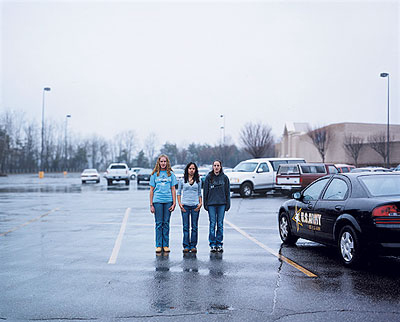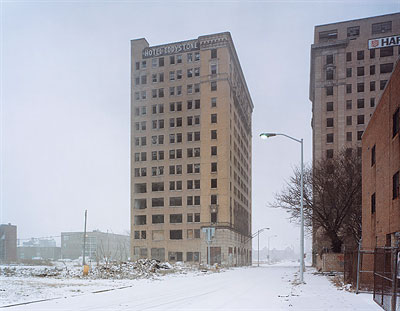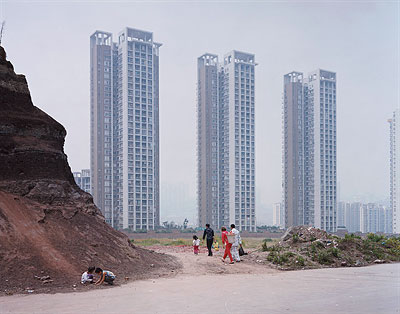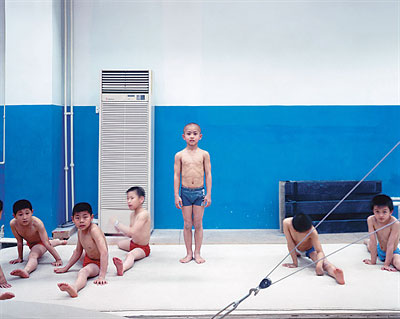| china/america
This is a remarkable series on China and America done in the UK but with photographs by American photographer Alec Soth.
America and China: The Eagle and the Dragon
Part one: Freedom fighters
With a $3 trillion war bill and an economy that flounders as China's soars, could America's era of dominance on the world stage be coming to an end? Mick Brown and the photographer Alec Soth travelled across America and China to observe how the future of these two great nations is intertwined, and to find out whether, in the run-up to the Beijing Olympics and the US election, we are on the brink of a new world order. In the first of a four-part series, they meet army recruitment officers in Virginia and cadets at West Point
|
Not least among the challenges faced by the US military in prosecuting the war has been maintaining a full and motivated fighting force at a time when popular sentiment against the war in Iraq is running at an all-time high.
America has had a volunteer army since the abolition of conscription by Congress at the end of the Vietnam War in 1973. But the drip-feed of news images of car bombs in Baghdad and body-bags returning from Afghanistan is not a good advertisement for recruitment. By the US Army's own admission, the desire to enlist is currently at its lowest point in two decades, with the army struggling to make the required 80,000 new recruits each year; while the cost of recruiting has never been higher - more than doubling in the 20 years between 1975 and 2005 from around $7,000 per enlistee to $16,000.
A disproportionately high number of these recruits come from rural communities, where job opportunities tend to be lower, and patriotic feeling runs higher. According to a study by University of New Hampshire's Carsey Institute the death rate for rural soldiers is 60 per cent higher than for soldiers from cities or suburbs: 'The dearth of opportunity in rural areas simply leaves more young people with fewer alternatives to the military,' the study notes. 'The opportunity differential between rural and urban America is probably higher now than at any time in the past.'
Nowhere is this mixture of rural hardship and patriotic sentiment more evident than in the neighbouring Appalachian states of West Virginia and Virginia.
Nowhere is this mixture of rural hardship and patriotic sentiment more evident than in the neighbouring Appalachian states of West Virginia and Virginia.
This had once been a flourishing mining area, but mining was in decline and many of the small communities and townships wore a used-up, sorrowful look; it seemed the only thing that continued to flourish here was faith. In Bradshaw, West Virginia - windblown and desolate - the Ten Commandments were posted in a square opposite the town hall, but even the pawn-shop had closed down.
| |

New recruits Kayla Smith, Lauren Martin and Priscilla Branch,
all aged 17, in the car-park of the Liberty Mall in Martinsville, Virginia,
where the US Army has a recruitment centre
[more]
thanks to Conscientious
America and China: The Eagle and the Dragon
Part Two: Requiem for a dream
Once symbolic of optimism and certainty, America's credit-crunched suburbs may be facing a decline as dramatic as that of Detroit, itself once a beacon of industry. Mick Brown and the photographer Alec Soth continue their investigation into the contrasting fortunes of the US and China
|
The birthplace of modern America - one might say the modern world - is a huge disused factory building that stands on a busy six-lane boulevard in a part of Detroit named Highland Park.
Outside, on a scrubby patch of untended grass, is a sign posted by the Michigan Register of Historic Sites stating that this was the factory where, in 1913, Henry Ford began the mass production of automobiles on a moving assembly line. By 1915 Ford had built a million of his Model Ts; by 1925 more than 9,000 were being assembled in a single day.
Mass production, the sign reads, soon moved from here to all places of American industry 'and set the pattern of abundance for 20th-century living'.
It is a wonderfully evocative phrase that stops you in your tracks - the pattern of abundance for 20th-century living. From here came the principles of mass production that provided the goods that fuelled the consumer society; from here, the automobile that begat the roads and the freeways that carried people and goods from sea - as America the Beautiful has it - to shining sea, and then to the world beyond.
The Highland Park factory was known as the Crystal Palace because of the amount of glass used in its construction. But its windows have long been shuttered and boarded. What remains of the plant is now used for warehousing, with one part given over to a retail outlet for a company selling cheap shoes made in China. Highland Park - a city within the city of Detroit - is so economically bereft that it can't even afford its own police department - the county police patrol there instead.
| |

As the birthplace of mass production,
Detroit 'set the pattern of abundance for 20th-century living'
[more]
thanks to Conscientious
America and China: The Eagle and the Dragon
Part Three: onward and upward
The thrusting tower blocks of Chongqing stand testament to the headlong economic growth that is changing the lives of millions of Chinese. Mick Brown and the photographer Alec Soth continue their investigation into the contrasting fortunes of the US and China by exploring the world's fastest-growing city
|
It was while sitting at the table in Lei Jing's dining-room, in his neat little house on the outskirts of Chongqing, overlooking the plot of land that his family had tended for generations, that the message of China's extraordinary economic boom became clear. We had driven out from the city that morning, through the dense forest of new skyscrapers and tower blocks (many still swathed in scaffolding) that were sprouting up in every direction in readiness for the hundreds of thousands of people who arrive in Chongqing each year from the countryside in search of a new life. We had swept along the newly constructed freeways, past the new private developments enshrouded in hoardings offering the seductive promise of a better future - AIR GARDEN BABYLON: TOP GRADE BRAND IN WORLD; REFINE CHINESE WISDOM: BUILD ORIENTAL VOGUE; LIVE FOR PLEASURE AND WIN THE WORLD.
Lei Jing had not yet won the world, but his life had improved, he said, in ways nobody could have dared to imagine 30 years ago. He was 36 and worked as a test-driver for a local car manufacturer. During the first period of reforms in China, in the early 1980s, his family had acquired their first washing machine and television set. And now, in the period of the second reforms, he had been able to buy a car and to finance the building of the house where we were now sitting.
'Everything is improving in China, especially material life. I am very proud of what is happening in my country.'
This, I said, was undoubtedly a good thing, but - how could I put this diplomatically? - what troubled many people in the West was the fear that China's newfound prosperity was being secured at our expense; in jobs, rising fuel prices, the cost to the environment. Lei Jing was an equable man, but a note of incredulity crept into his voice. 'That's not the case!' he said. 'The Chinese culture is such that we feed ourselves and are satisfied with ourselves and our own environment. China does not intend to be a threat to the Western nations.' Lei Jing gave a polite smile. 'We don't want much. Only what everyone wants.'
| |

Chongqing's authorities plan to move two million people from the countryside
into newly developed areas such as this within five years
[more]
thanks to Conscientious
America and China: The Eagle and the Dragon
Part Four: Higher, faster, stronger
With the Beijing Olympics, China hopes to cement its position alongside the USA on the podium of global power. In the final part of their special investigation, Mick Brown and photographer Alec Soth examine how both nations are playing the Games
|
The new National Stadium in Beijing - the Bird's Nest, as it is known - an elaborate latticework, like stainless-steel macrame, is one of the great architectural marvels of the modern world. And its effect is to stun everyone who sees it into a moment of silence. Standing on the road abutting the stadium, and gazing towards it over a wooden fence, Mr Ling wore the expression of a man in the throes of something approaching rapture. He was from Beijing, he said, a civil servant, now retired. He was wearing a T-shirt emblazoned with the message I CAN BELIEVE THE WORLD. 'Emotionally,' he said, 'I feel more self-esteem and excitement than I have ever felt. I will remember this moment my entire life.'
China has a lot invested in the Olympic Games - and not only the $20 billion that has been spent on building the new sports stadiums, airport terminals, subways and other facilities that will serve the city in the long term. More significantly, it has the investment of national pride: $20 billion is roughly the same amount that, 40 years ago, the US spent on putting the first man on the moon - a demonstration to the world of the primacy of America and the capitalist way. The Beijing Olympics might be seen as China's moon-shot - the showpiece of the nation's emergence as a global power. From my hotel window I looked on to the CCTV Tower, the new headquarters of China's state broadcaster, yet another architectural marvel comprising two glass blocks in an inverted 'L' shape, fused into one vertigo-inducing structure. Below it a huge hoarding pictured a troop of soldiers marching purposefully beside a message in Chinese and English: TO PROVIDE A CLEAN ENVIRONMENT AND GOOD SERVICE FOR OLYMPICS - SERVING WITH HEARTS, MINDS AND SPIRIT.
| |

The Shichahai Sports School in Beijing, the flagship
of the Chinese government’s athletics training programme,
has about 600 pupils aged between six and 18
[more]
thanks to Conscientious |

